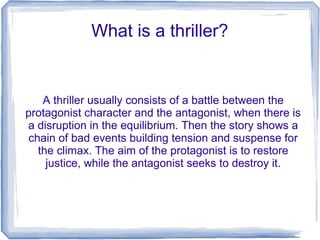Thriller conventions
- 1. What is a thriller? A thriller usually consists of a battle between the protagonist character and the antagonist, when there is a disruption in the equilibrium. Then the story shows a chain of bad events building tension and suspense for the climax. The aim of the protagonist is to restore justice, while the antagonist seeks to destroy it.
- 3. Conventions of thrillers ïŽ Low-key lighting ïŽ Quick cuts ïŽ Shadows ïŽ Suspenseful music ïŽ Protagonist is at the mercy of the antagonist ïŽ Eery/mysterious locations
- 4. Characters ïŽ The main protagonist is often a brave hero- type character who seek to restore the equilibrium. ïŽ The main antagonist usually has a hidden identity from the audience, making us guess throughout the film while it is being slowly revealed, ie the serial killer in Se7en.
- 5. Themes ïŽ The storyline is usually designed so that the audience feel like it could happen to them, increasing the suspense and possibly fear.
- 6. Cinematography ïŽ Lots of close ups of characters' faces to show emotion. ïŽ Harsh, high contrast lighting. ïŽ Lots of shadows. ïŽ Shots of the antagonist will usually hide their identity â commonly find them in silhouette.
- 7. Editing ïŽ Editing techniques vary, from slow editing/cuts to build suspense, to fast action edits. ïŽ Continuity editing is of course used to help the audience understand the film. ïŽ Jump cuts are often used to compress time.
- 8. Sound ïŽ Sound in thrillers is primarily used to create suspense, shock etc. ïŽ The music often begins at a slow pace and tempo and gradually builds to create this suspense.
- 9. Mise en scene ïŽ A location that helps to establish a theme, such as a bank. ïŽ Antagonist in dark clothes, protagonist usually in every-day clothes. ïŽ Placement of characters has semantic connotations ïŽ Lots of weapons
- 10. Mise en scene ïŽ A location that helps to establish a theme, such as a bank. ïŽ Antagonist in dark clothes, protagonist usually in every-day clothes. ïŽ Placement of characters has semantic connotations ïŽ Lots of weapons









